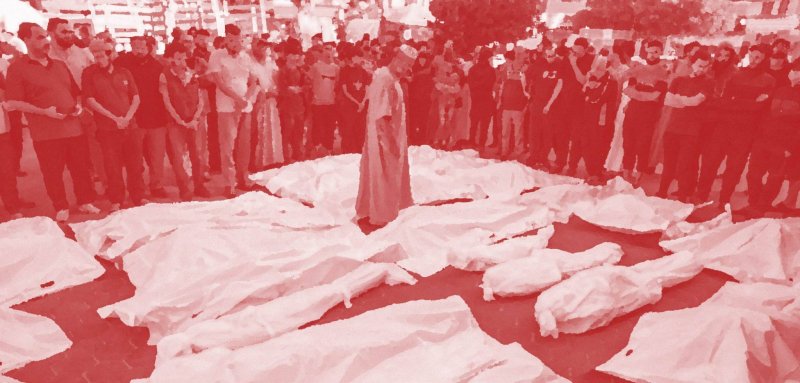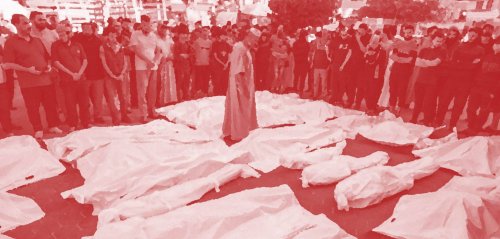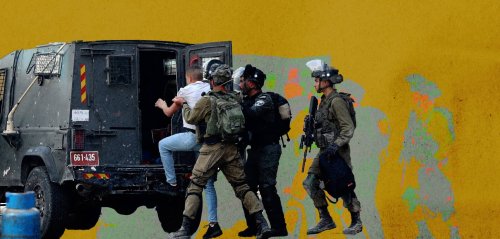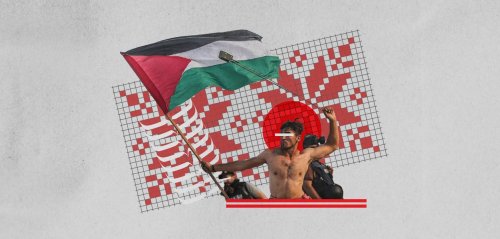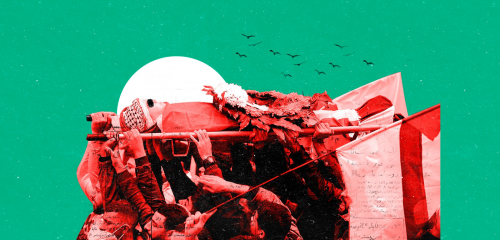Settler colonial policies are not only limited to controlling the capabilities of nations and managing colonies. They consistently employ criminal methods to achieve their key objectives and most prominent goals, including bringing about demographic, racial, and social change through the extermination or displacement of indigenous populations, and replacing them with new settlers. Over time, these lands become "a right" firmly owned by the occupier. Palestine is the clearest example and one of the victims of these colonial settler policies.
Throughout history, Britain has distinguished itself in the utilization of colonial settler practices in many countries of the world. Before the end of colonialism post-World War II, it, along with other historical settler nations, took a different approach, through the establishment of the state of Israel. With the aim of altering the demographic composition between Arabs and Jews, the first massacres were committed against the Palestinian people in 1936 during British colonialism. It remained intermittent for a decade but escalated significantly in 1947 and 1948, the two years preceding the declaration and establishment of the "State of Israel", when 49 massacres were committed.
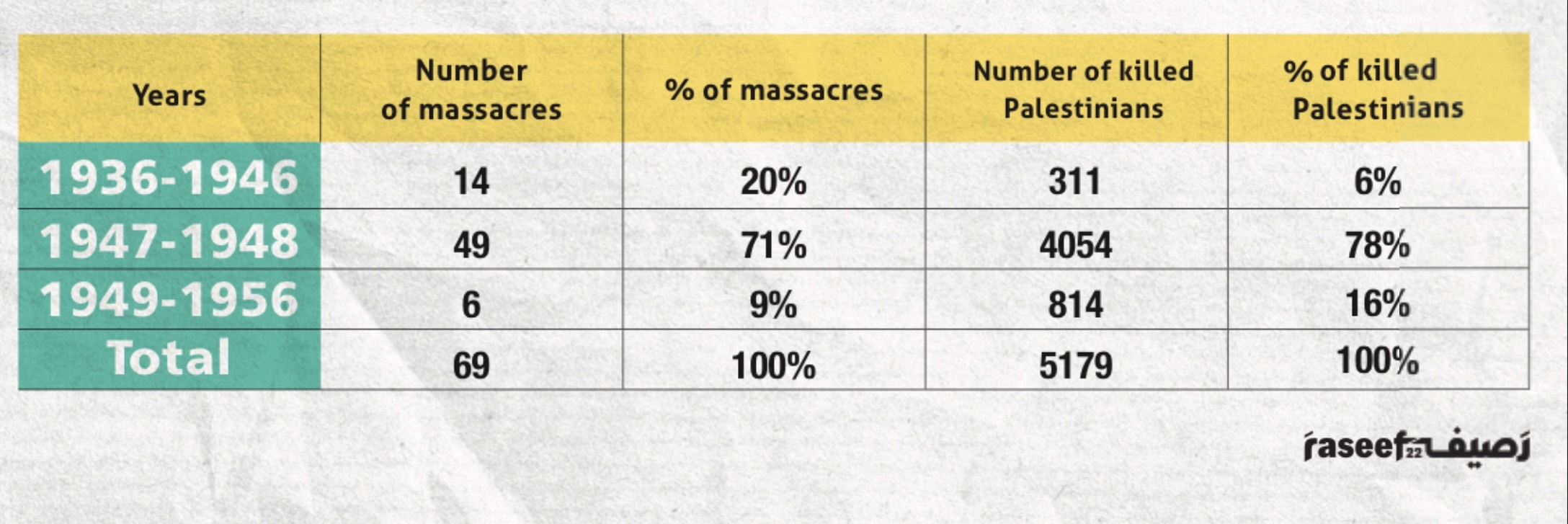 Number of massacres committed between 1936 and 1956
Number of massacres committed between 1936 and 1956
The role of Israeli massacres as displacement tools
Examining the locations of where these massacres were committed over a period of two decades – from 1936, the date of the first massacre, to 1956, the date of the 'Tripartite Aggression' (the Suez Canal War) – confirms the displacement function of these massacres. 93 percent of these massacres (64 out of 69 massacres) occurred in Palestinian districts later known as "the territories of '48", that is, the internationally recognized borders of the state of Israel, constituting 78% of the land of historic Palestine. 53 massacres between 1936 and 1948 were sufficient for the establishment of Israel, with international recognition, following the forced displacement of Palestinians to the internal territories (the West Bank and Gaza Strip), as well as to Syria and Lebanon in particular.
While committing these massacres, Zionist gangs and paramilitary groups adopted a tactic that allowed an escape route for the locals who were able to survive, and to inform other villages of the atrocities with the intention of spreading terror among Palestinian villages and pushing residents to "save" themselves.
While committing these massacres, Zionist gangs and paramilitary groups adopted a tactic that allowed an escape route for the locals who were able to survive. What distinguishes this from what is being done today in Gaza?
This policy succeeded at the time, resulting in the death of approximately 1% of the Palestinian population and the forced displacement of up to 81% of them. The number of Palestinians in the cities and villages that were declared as "the State of Israel" was around 800,000 people, with approximately 650,000 of them being displaced. In return, they brought in Jews from various parts of the world, especially Russia, Eastern Europe, and France, in order to settle them on Palestinian land, reaching a population of 600,000 during the first two years of the state's establishment.
According to a study published by the Jerusalem Center for Studies on the history of Jews in Palestine, until 1839, the number of Jewish immigrants heading to Palestine was 6,000, compared to 300,000 Arab Palestinians. This indicates that the Jewish population did not exceed 2% at that time. However, organized waves of migration from various parts of the world over the following six decades raised the Jewish population in Palestine to approximately 559,000 Jews. The Palestinian Central Bureau of Statistics indicates that the population of Palestine in 1948 amounted to more than two million, with around 31.5% being Jews.
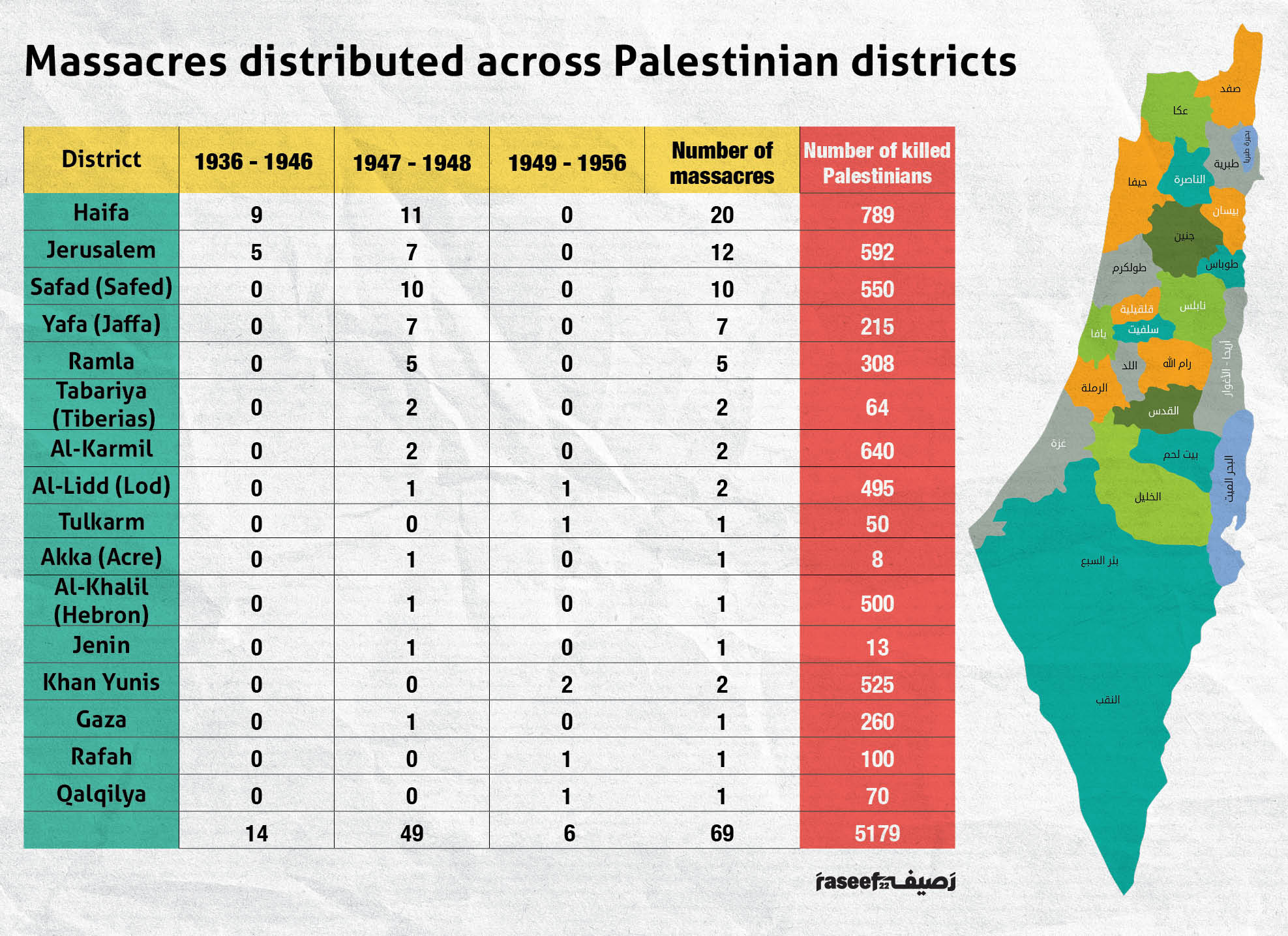 The distribution of massacres across Palestinian districts
The distribution of massacres across Palestinian districts
Zionist gangs establish the army... and the massacres continue
The distribution of massacres in Palestinian districts reveals the grim aftermath of the formation of the "State of Israel" in 1948.
After the declaration of the "State of Israel" in 1948 and the withdrawal of British forces, Zionist gangs led by figures such as Moshe Dayan, Ariel Sharon, and Menachem Begin formed the Israeli army, which continued the massacres, escalating them to a more heinous level. By 1956, the number of victims of these massacres almost equaled the number of victims of the Zionist gangs before 1948.
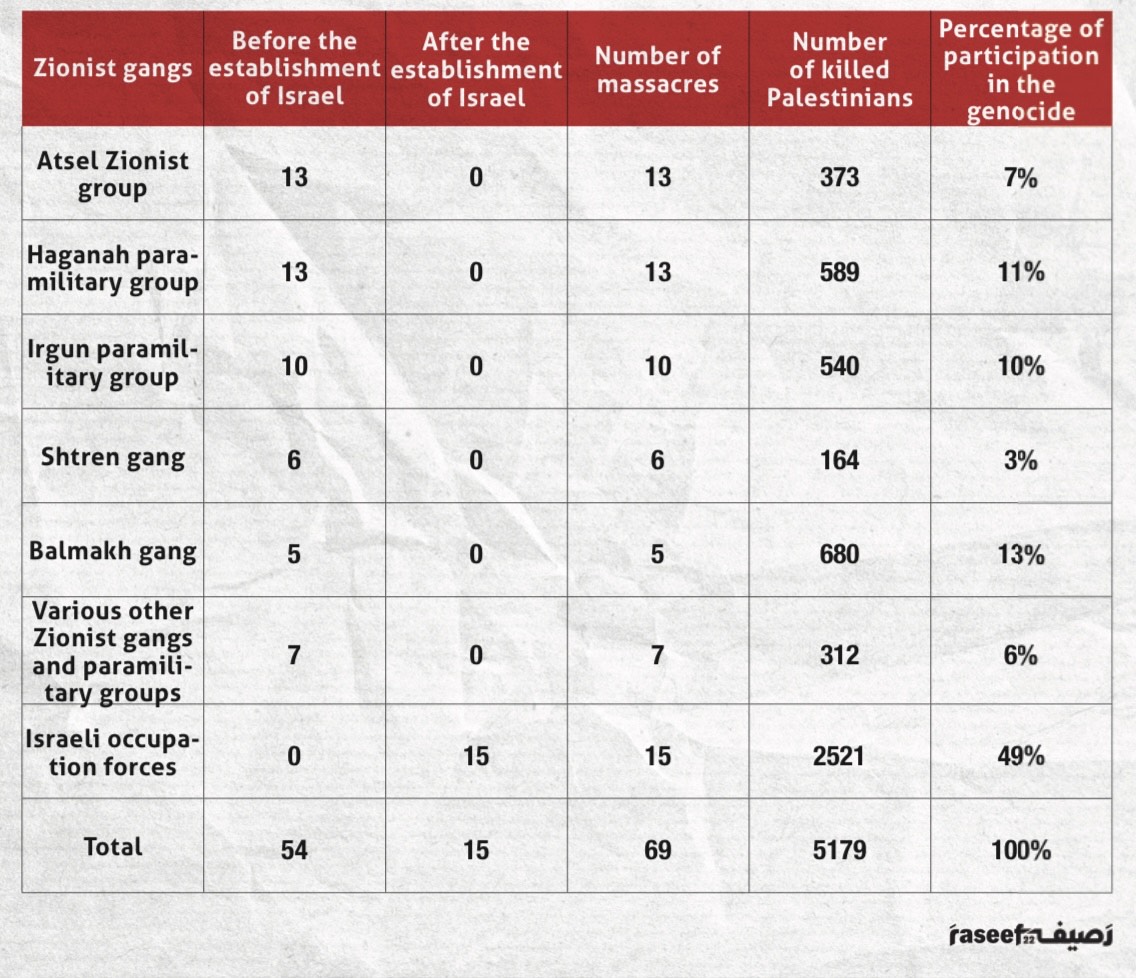 Massacres committed by Zionist gangs and paramilitary groups
Massacres committed by Zionist gangs and paramilitary groups
Assaults on the Palestinian people: Varied forms of aggression
The nature of the attacks on the Palestinian people have taken various forms, predominantly through armed assaults on villages and farms. These assaults are frequently marked by horrific acts, including the brutal slaughter and burning of neighborhoods, actions intended to instill fear and coerce Palestinians into abandoning their homes. A stark illustration is the Deir Yassin massacre, where approximately 360 Palestinians were killed. Additionally, Instances of rape and the burning of a girl in front of her family further highlight the brutality. In the Tira-Haifa massacre, Zionist gangs transported between 60 and 80 civilians by buses to a field near the town of Afula, dousing them with gasoline and burning them alive at noon. The percentage of casualties in the massacres carried out by armed attacks constituted 84% of the total victims of the Zionist massacres.
The attacks also included throwing grenades at Palestinian gatherings, especially in markets and cafes. Barrel bombs and explosive devices were used to target homes and hotels, in addition to car bombs and train bombings.
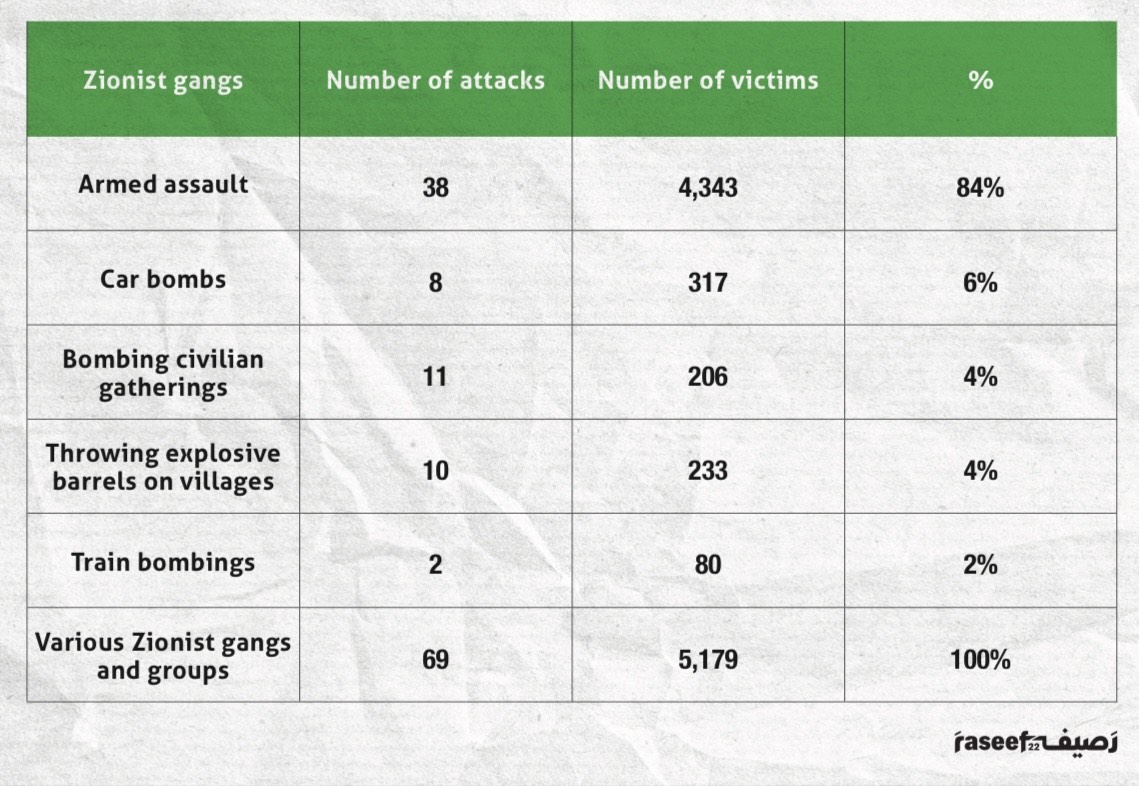 Types of attacks perpetrated by Zionist gangs
Types of attacks perpetrated by Zionist gangs
Samer Manna, a researcher specializing in Palestinian affairs, tells Raseef22 that "since its establishment, the Zionist entity has consistently aimed to establish the foundations of its state over the largest geographical expanse and with the largest number of Jews. This ambition aligns with the central Zionist ideology that mirrors the Israeli society's overwhelming majority," adding that this ideology has "been in place since before the Nakba of 1948 and persists through the ongoing aggression on the Gaza Strip, starting with Theodor Herzl, representing what is known as liberal Zionism, to Benjamin Netanyahu, symbolizing the new conservative Zionism."
Manna explains that "Zionist ideology centers around four key ideas: expanding territorial annexation, national separation, theological superiority, and hegemony. David Ben-Gurion, the first Prime Minister of the Zionist state, overtly expressed the Zionist thought and its goals, stating that: 'The situation in Palestine will be settled by force'. This was implemented through various means, notably the forced evacuation of Palestinian residents from their lands and the erasure of anything affirming the cultural and historical existence of the Palestinian people. The tangible result of this ideology manifested in the Nakba of 1948, through the terrorism and intimidation carried out by Zionist gangs."
At the time, Manna notes that "the countries that emerged victorious in World War I, particularly the United States, Britain, and France, helped in the ethnic cleansing of Palestinians. These same countries continue to support the Zionist occupation today in its current aggression against the Gaza Strip. The international community also contributed, failing to develop mechanisms to curb the Zionist killing machine. The most glaring aspects of ethnic cleansing appeared in massacres and attempts to obliterate and displace entire villages, witnessed in over 530 Palestinian villages."
Manna emphasizes that "in all these massacres, the constant aim was to legitimize terrorism through genocide to create an environment conducive to ethnic cleansing. This involved the complete evacuation of the region and geography, the eradication of entire villages, and their replacement with Jewish settlements, or leaving them as barren areas with Jewish names."
The ongoing assault on Gaza: a continuation of genocide and displacement
Despite all the criminal policies committed by Israelis in Palestine, along with acquiring three-quarters of the historical Palestinian territory, they persist in their policy of displacement. The discovery of substantial gas fields in northern Gaza and its sea cannot be ignored, as it adds another layer to their ongoing process of ethnic cleansing. In 2000, Yasser Arafat inaugurated an official agreement between the Palestinian Authority and the British Gas Company concerning the "Gaza Marine 1" field. They sabotaged the Oslo agreement and proceeded to eliminate its advocates, Yitzhak Rabin and Yasser Arafat, then intensified settlement efforts in Gaza and the West Bank.
Circumstances now closely resemble past events on all fronts: the world is watching, but it only prioritizes its regional and international interests; alongside an Arab world preoccupied with narrow interests, and a fragmented people without a clear vision
In the ongoing Gaza offensive, Israel persists in its colonial and settler-colonial strategies, aiming to eliminate as many Palestinians as possible and displace the remaining population. Drawing from the tactics used in the 1948 massacres, Israel deliberately targets civilians in northern and central Gaza, creating an opportunity for them to escape to the southern borders with Egypt, laying the groundwork for mass deportations towards the Sinai Desert.
According to Manaa, "The Zionist killing machine continues its blatant ethnic cleansing operations in Gaza, but the difference this time is that the severity of the atrocities is happening right in front of the international community, backed explicitly by the West. There's technological advancement in using internationally prohibited weapons like phosphorus bombs and seismic missiles, and a huge amount of missiles equivalent to two nuclear bombs, alongside threats of making a nuclear strike in this era of human rights. Faced with military setbacks and failures, Israeli forces are engaging in an ethnic cleansing and genocidal war, killing over 10,000 Palestinians, nearly half of whom are children, in near-daily massacres such as the Baptist Hospital massacre and those that took place in Jabalia and Nuseirat camps. This comes coupled with a ruthless starvation campaign and the cutting off of various supplies, including fuel, electricity, water, and medicines, in the ugliest forms of collective punishment."
Razi Nablusi, a researcher at the Institute for Palestine Studies, notes, "Since 1948, Israel has treated Palestinians as natural obstacles, similar to mountains and trees that can be removed to facilitate the Zionist project in Palestine. This has been accompanied by a major process of dehumanization and a denial of the existence of the Palestinian people and identity. What is happening today does not differ in terms of ideological framework, military power, or open calls for expulsion. Although it is unfolding before the world's eyes, the circumstances do not differ much from past events on all fronts: the world is watching, but it prioritizes its regional and international interests above all else; an Arab world dominated and preoccupied with small interests, and a fragmented people without any vision or unified political system."
Other sources: Encyclopedia of Palestinian Villages, Institute for Palestinian Studies, Center for Palestine Studies, The Historic Encyclopedia
Raseef22 is a not for profit entity. Our focus is on quality journalism. Every contribution to the NasRaseef membership goes directly towards journalism production. We stand independent, not accepting corporate sponsorships, sponsored content or political funding.
Support our mission to keep Raseef22 available to all readers by clicking here!
Interested in writing with us? Check our pitch process here!
